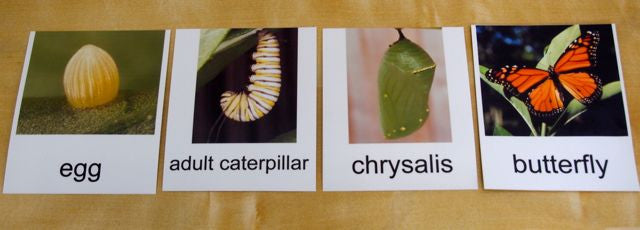Butterfly Life Cycle Models & PDF of 3 Part Cards
A set of beautiful, detailed and realistic models representing the four main stages of the life cycle of the butterfly. The models show the egg, the caterpillar, the chrysalis and the adult butterfly. This set is ideal for introducing the cultural concept of life cycles - and the magic of metamorphosis - and can be complemented by our other life cycle sets including the Frog, Chicken, Turtle, Ladybug and Plant.
This set also includes a PDF of Montessori 3 Part Cards specially designed to match the life cycle models for you to print at home. The cards illustrate the four stages depicted by the models but also include additional stages to tell a more comprehensive 'life story'. The Butterfly 3 Part Cards show the egg, larva (young caterpillar), adult caterpillar, chrysalis, butterfly emerging from chrysalis, adult butterfly and butterfly laying eggs.
Providing the cards in PDF ensures you have the flexibility to replace missing or damaged cards over the years.
The corresponding "Three Part Cards" can be used for a variety of purposes:
- Use just the large 'control' card (with picture and word) to lead the child towards abstraction by identifying illustrations.
- Encourage 'matching' skills as the child matches the object to the large card.
- Promote more advanced matching skills by allowing the child to match the smaller picture-only card to the control card.
- Introduce early literacy skills such as letter identification and whole-word recognition as a child matches the word-only card to the control card.
- Play a 'memory game' with the control card and picture card. Flip the cards over to show the blank side up. Assist a child to flip one of the larger cards first, to reveal its picture, then flip one of the smaller cards to try to find its mate.
When presenting the 'Three Part Cards' as a matching game please remember to encourage the child to keep each image or word visible (as shown in the fourth picture in our photo gallery). Don't present it as a "snap" style game (where the matching card covers its mate) because this removes the 'control of error'. If all cards remain visible then the child can review his or her work to identify and correct any errors!




